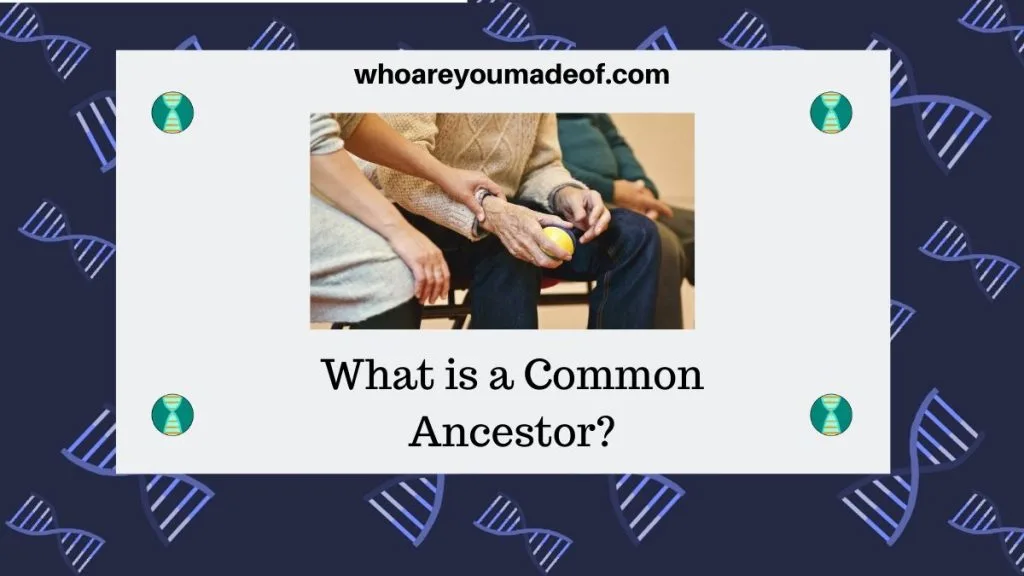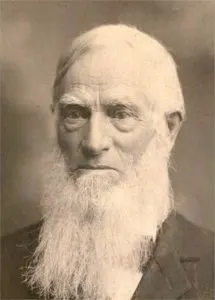Have you ever wondered what you call the "link" between you and your relatives? There is a special term that people in the family tree research or genealogy field use to describe this relationship: common ancestor. What is a common ancestor?

This comes up a lot during genetic genealogy, since when I look at the family tree of a DNA match, I am usually looking for common ancestors, and especially our most recent common ancestor (MRCA), which will help me figure out our exact relationship.
What is a Common Ancestor?
A common ancestor is a person (ancestor) that you and another person, or a group of people, are descended from.
The term can technical be used to describe the ancestor that you are descended from, or any of their ancestors - since you are also descended from them. That's why I prefer to use the term Most Recent Common Ancestor. You will often see this term abbreviated as MRCA.
What is a Most Recent Common Ancestor?
The man in the very old photograph below is Samuel Sudborough, who was born in England in 1815. He is my great-great-great-great grandfather and he was married at least three times and had children with each wife. All of his great-great grandchildren (and those great-great-great-great-great grandchildren that probably exist!) all share this man as our most recent common ancestor.

In other words, he is the most recent person that we are all related to. We could go further back in all of our trees and find that we are also related through Samuel's ancestors. But the most useful thing to know is that we are all related to Samuel. This can help us figure out if we are 3rd cousins twice-removed, or 4th cousins once-removed, or any other potential cousin relationship.
The man in photo, Samuel, also had ancestors. I also share all of those ancestors in common with the rest of his descendants.
You Can Have More Than One Common Ancestor
Usually, you will have a pair of common ancestors - i.e. your grandparents, who had multiple children together. Those children of your grandparents (your aunts and uncles) had children - your cousins. You already know who your MRCA is - your grandparents. It can easily be murky thinking back through more generations, however.
Sometimes, however, you can be related to someone in more than one way!
This comes up often in my DNA matches. I'll find that I share a higher amount of DNA with one of my cousins than either my mother OR my father. If I can't inherit DNA from my parents that they didn't have, it can often mean that I am related to that cousin on both sides of the family.
There are other ways that you can be related more than one way to someone, and have more than one set of common ancestors. This is also a very common experience for people who have lots of ancestors from the same part of the country or the world. For example, take people who have several family lines that go all the way back to colonial times in the US. If you are comparing your tree with your relative who also has lots of ancestors from the same area, you might find that you have more than one branch of your tree where you have an ancestor in common.
Different ancestors, different lines lead to multiple common ancestors.
This means that you can be a 4th cousin-twice removed AND a 5th cousin three-times removed to the same relative! (Read about what these cousin relationships mean).
Have you built your family tree or taken a DNA test yet?
While you are here, I thought I would mention to you two helpful posts that can help you out if you are considering taking a DNA test or building your family tree:
- Beginner's Guide to Building a Family Tree
- The Ultimate DNA Testing Strategy (how to pick a test)
I generally recommend building family trees on Ancestry. It's a free and simple way to get started. You can even share your tree with family members to allow them to help you build your tree - and it's completely free.
Even though you don't need a subscription to build a tree, you do need one to get access to documents, records, and other family trees.
Conclusion
I hope that this post helped you understand the common ancestor concept. I would love to hear from you in the comments if you have any more questions or concerns.

Shirley Ostwald
Sunday 6th of October 2024
I think this useful to be able to cluster. If I use my great, great, great grandfather, Johann Ostwald, born in Prussia in 1794 or in my mum’s side my great, great,grandfather born in Sweden, Charles Johnson , in 1799 I not sure how to cluster. It sounds interesting but not exactly easy. Do you have anymore information to do this I enjoy your regular posts
Lori Pavlu
Saturday 28th of September 2024
I found charcoal portraits of a couple at a recycling yard in Taos, NM, years ago. They were sandwiched between Styrofoam sheets that had "Samuel Sudborough, 1815-1905 & wife", written on the outside. I'm hoping to get these to family. I believe this is the same person in the photo above, though younger. Please respond so we can achieve this.
Mercedes
Sunday 29th of September 2024
Hi Lori, Can you send me an e-mail at [email protected]? I would be very interested in seeing these portraits, as Samuel Sudborough was my ancestor. Thank you!
Teresa
Friday 26th of April 2024
If l have a Common Ancestor match on my dads Paternal side but is showing on thru lines as belonging to my dad's maternal line, what does this mean? Is it a mistake?